Today, monolithic construction is gradually moving from the field of industry to the sphere of the private sector. Landowners have appreciated this technology and are increasingly using it in the construction of mansions. The use of floor casting turned out to be much more profitable and efficient than buying prefabricated slabs. An excellent help in achieving a high-quality result at this stage of construction is a telescopic formwork stand. This compact, lightweight and handy fixture is designed to create a support for horizontal fragments of molds for floor casting. A wide range of these devices is on sale today. They can be bought or rented, but first you should study their features and rules of use.
Defining the Formwork Stand
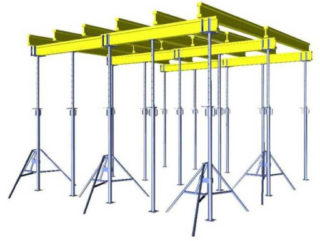
The slab formwork props are telescopic supporting structures. Outwardly, they look like pipes on a tripod with controls located on the sides. Products are made of alloy steel, resistant to corrosion, vertical and horizontal stress. The formwork stand is adjustable in height using a screw device, which ensures a tight fit of the supports to the desired size with millimeter accuracy.
The device is simple and reliable. Relatively small dimensions and low weight make it possible to work with telescopic formwork props even alone, which significantly reduces the construction budget. Sliding legs have a wide range of applications in the private and industrial sector. With their help, horizontal slabs with a thickness of up to 40 cm are manufactured. The equipment can be purchased in the retail network, on the Internet, but for a one-time event it is advisable to rent it.
Formwork props classification
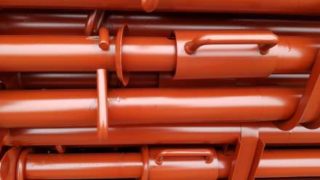
The industry produces formwork props in different dimensions in terms of size and bearing capacity. One of the fundamental differences is the location of the threads for adjusting the head lift.
There is the following classification of support products:
- With open threads. In such struts, the thread is rolled directly onto the tensioning element and is in the open state. The advantage of this solution is that the pipe thickness is used as much as possible while maintaining technological strength. Added to this is the ease of cleaning and lubrication. The downside is that construction work is a dirty and dusty process. If foreign objects get on the thread, you need to stop it and spend time cleaning. In addition, abrasive particles in the lubricant accelerate tool wear.
- With closed thread. The difference is that there is a metal sleeve on the tensioner, which completely protects the screw mechanism from all contamination. This technology helps to increase the life of the racks, extending the period between services. The downside is the increase in the size of the supports and the higher cost of production.
Choosing the type of telescopic racks, you need to optimally assess the conditions of the upcoming activity, correctly correlating the pros and cons of each option. When erecting heavy slabs, you can use reinforced racks with thickened walls.
Telescopic structure composition and dimensions
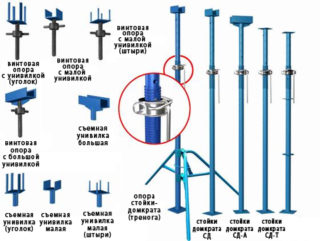
The telescopic stand (jack) for formwork has a simple and at the same time reliable device. The minimization of the number of parts makes this device convenient to use, bringing into working condition is carried out quickly and without complications.
The adjustable support consists of the following parts:
- Lower outer tube. Made of steel or aluminum. A support platform with holes for fasteners is welded to the base. On the upper part there is a nozzle with an external thread.
- Telescopic insert (inner tube). It has perforations along the entire length with an interval of 110-150 mm. On the upper cut, there is a support platform for installing forms for laying beams.
- Support nut. Designed to connect the inner and outer parts, support for the fixing part.
- Fastening earring. Serves for setting the required height of the support before starting the unscrewing of the lower part. It is inserted into the holes of the inner pipe.
- Tripod for formwork. It is a structure of bent pipes that rigidly fix the formwork support in the desired position and takes on part of the load.
In order to protect against corrosion, the parts are covered with zinc and painted with powder enamel.
The industry produces support legs with the following height and weight standards:
- 1.2-2.1 m - 9.5 kg;
- 1.4-2.5 m - 10.6 kg;
- 1.7-3.1 m - 11.9 kg;
- 2.0-3.7 m - 13.7 kg;
- 2.5-4.2 m - 15.2 kg;
- 3.0-4.5 m - 16.2 kg.
Products have a sufficient margin of safety to be stored and transported in stacks. In order not to scratch the coating, it is recommended to wrap the pipes with thick paper, film or rags.
Characteristics and scope
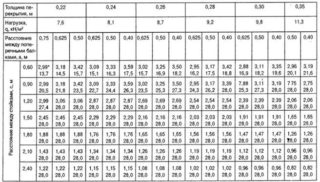
Telescopic supports, depending on their type and model, have the following technical characteristics:
- bearing capacity - 800-1500 kg;
- overlap thickness - 20-40 cm;
- height - 120-450 cm;
- type - standard, reinforced;
- outer diameter - 60-76 mm;
- weight - 9.5-16.2 kg;
- installation interval - 100-150 cm;
- pipe wall thickness - 2-3 mm
The scope of application of telescopic supports covers both private and industrial construction. The method of erecting floors by pouring allows you to erect structures with individual parameters, without being tied to the standard of slabs produced by the industry. In addition, there is no need to purchase, transport and raise concrete products with a large weight and size to a height. All this made it possible to increase the level of security and remove restrictions on the configuration of facilities under construction.
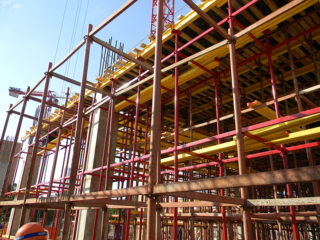
Racks are used when erecting floors of structures of this type:
- multi-storey buildings;
- offices, salons, studios;
- private houses, summer cottages, cottages;
- garages and sheds;
- baths;
- vegetable stores;
- industrial premises.
The list goes on and on, as the props have proven to be effective in creating flood ceilings on any type of facility.
Installation work and necessary tools
The installation of supports under the beams can be carried out alone, but for work at height it is better to have an assistant.
You will need the following tools:
- a lever for turning the pipe;
- level;
- puncher;
- screwdriver.
It is advisable to carry out the installation with gloves so as not to damage the hands.
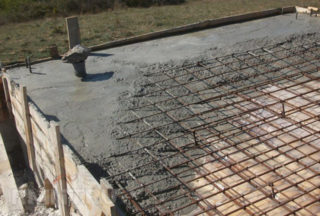
Installation is carried out in the following sequence:
- Cleaning the site from debris and unnecessary items that may interfere with work.
- Setting up and aligning the tripods, raising the clamps.
- Lowering the legs into tripods, fixing the pipes with clamps;
- Raising the sliding part to the required height, fixing the position with an earring.
- Fastening uniloks, laying them longitudinal and transverse beams under the formwork.
- Height adjustment with support nuts.
- Installation on the walls of the support corners around the perimeter of the room.
- Laying of formwork (boards, plywood, sheet metal, profiled sheet).
The use of telescopic stands allows you to achieve high-quality results with a minimum level of waste and physical effort.








